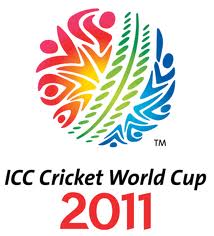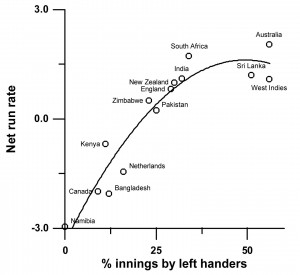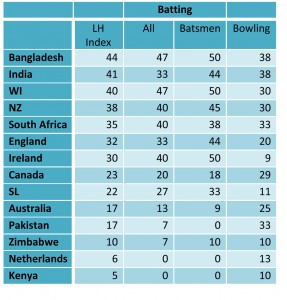 As the 2011 cricket World Cup dawdles toward the knockout stages, I’ve been mining the team sheets for any reason to believe my beloved South African Proteas can overcome their long tradition of wobbling in this tournament and finally secure some silverware. I took a look back at a paper I wrote about the 2003 tournament on the role of left-handers in tournament performance, and I found little comfort there. In fact, we should put our money on a final between India and Bangladesh.
As the 2011 cricket World Cup dawdles toward the knockout stages, I’ve been mining the team sheets for any reason to believe my beloved South African Proteas can overcome their long tradition of wobbling in this tournament and finally secure some silverware. I took a look back at a paper I wrote about the 2003 tournament on the role of left-handers in tournament performance, and I found little comfort there. In fact, we should put our money on a final between India and Bangladesh.
Back in early 2003, I had just become a father for the first time, and I was on the night-shift looking after my son while my partner got some sleep. As a result I spent a lot of time watching the Cricket World Cup on late night television (I live in Sydney and the tournament was in South Africa). I began to get irritated every time the commentators droned on about the benefits of having a left-hander and a right-hander batting together because it “breaks up the bowler’s line”. It was as if a professional athlete might be surprised in his delivery stride to find he had to deliver to a leftie rather than a right-hander. It also occurred to me that the tournament was a perfect place to test this idea.
It turned out that 24 % of the batsmen were left-handed, but there were far more batting southpaws among the specialist batsmen (47%) than among the bowlers (12% – pretty much the average level of left-handedness in the general population). The most successful teams (in terms of net run rate) were the ones with closest to half their innings batted by left-handers (see graph opposite). The best cricketing teams tend to have a balance of lefties and right-handers – at least among the batters.

But there was absolutely no advantage of having a left-right combination at the crease together. Partnerships but left-right combinations were no bigger, lasted no longer and scored runs no faster than combinations of two lefties or two right-handers. So if the commentators could please shut up about the advantage of having a left-right combination at the wicket, I would appreciate it.
Why, then, are the top teams stacked with southpaws? It turns out that they don’t score any faster than right-handers, but they do bat for longer (around 25 balls, compared with 15 balls for RHB). Lefties were less likely to be dismissed by a ‘bowler’s wicket’ –dismissals like bowled, lbw and caught behind that owe most to batting proficiency. We also found that this advantage came almost entirely at the expense of the weaker bowling sides, mostly the associate nations. The better bowlers are especially good at targeting left-handers. Those better bowlers tend to come from countries with plenty of good left-handed batsmen – something is happening that makes lefties rise like cream in the better domestic leagues (dare I say, like Australia’s Pura Cup?).
What seems to be happening is that in the less competitive domestic cricket leagues, sheer batting talent tends to dominate, and so the number of left-handers hovers around the 10-12% found in most left-handed traits in most countries. But as leagues become more competitive, so any tiny advantage becomes more important. Being left-handed is an advantage to a batsman because bowlers are used to targeting right-handers most of the time. This small element of surprise gives lefties a boost that right-handers don’t get at school- or club-level and even into state, county or provincial cricket. But the advantage withers the more left-handers succeed; bowlers get increasingly used to bowling at lefties and find just as many ways to get them out. That’s why we don’t expect lefties to take over the sport entirely.
Cricket isn’t the only spot where lefties rule as long as they are rare. They enjoy an advantage wherever there is a contest; in sports like tennis, baseball, boxing, fencing and even wrestling. Right-handed boxers are used to facing other right-handers, but their occasional southpaw opponents are used to fighting right-handers. The southpaw has the advantage of unfamiliarity.

A similar dynamic is probably also responsible for the fact that all human populations enjoy a small proportion of left-handers. For most of human history, men who excelled in hand-to-hand combat tended to leave more children than those who couldn’t wield a weapon. Good fighters not only outlived their opponents, but they had more matings – especially since men mostly fight about women or to establish the dominance and respect they need in order to attract wives. Men who fought with their spear, axe, sword or knife in the left hand would have enjoyed a considerable advantage in fighting opponents used to defending themselves against right-handers.
Enough about evolution; who is going to win the Cup? I’ve had a look at the official World Cup squads, and there are a few surprises. I’ve made an index of team left-handedness which basically takes the percentage of batsmen who bat left-handed and the percentage of bowlers who bowl left-handed, and averages those two numbers. The associate nations, as I predicted, tend to fall down this list. The exception, Ireland, is stacked with left-handed batsmen and all-rounders but has only one left-armed bowler, the 18-year old George Dockerell who has proved a revelation at this Cup.
Some favourites actually fare worse than Ireland and Canada. Australia realized their predicament and rushed Mike Hussey in to cover their complete lack of left-handedness among their top 7 batsmen, but that did come after the loss of left-arm seamer Doug Bollinger, leaving Mitchell Johnson the only real left-arm bowler (like the rest of the world, I don’t count Michael Clarke). The winner of the last three Cups looks hopelessly exposed on the left hand side. Pakistan are even worse off, with no left-handed batsmen and only a few lefties among the bowlers. And Sri Lanka are depending rather heavily on Kumar Sangakkara and Upul Tharanga.
My beloved Proteas aren’t that far off, with Smith, Duminy and Peterson starting regularly, but maybe Parnell or Tsotsobe could do with a bowl? The real surprise is at the top of the table. Bangladesh has the most balanced side from a handedness perspective, followed by India. That is why I’m predicting a Bangladesh-India final. At least I would be if I really believed handedness was a predictive weapon.
Remember that our 2003 paper showed that left-handers only really flourish against weaker opposition. With the group stages almost out of the way, the playing field is going to be more level. Talent, strategy, mental toughness, and luck are going to come to the fore. The Proteas have always had the first two and this side certainly has the toughness. Luck is something the Proteas just haven’t had, but I’m ever hopeful that they can’t get any unluckier than they were in 1992 and 1999.
……
Remember to follow me @Brooks_Rob on Twitter
My original paper “Sinister Strategies Succeed at the 2003 Cricket World Cup” was published by the Proceedings of the Royal Society of London.
So I was wrong about that. Of course I was. I don’t think aven the most optimistic Bangladesh supported had thought they might make the final. My original paper was about individual performance. It takes a great many individual performances to create the big aggregate outcome of making it to the finals.